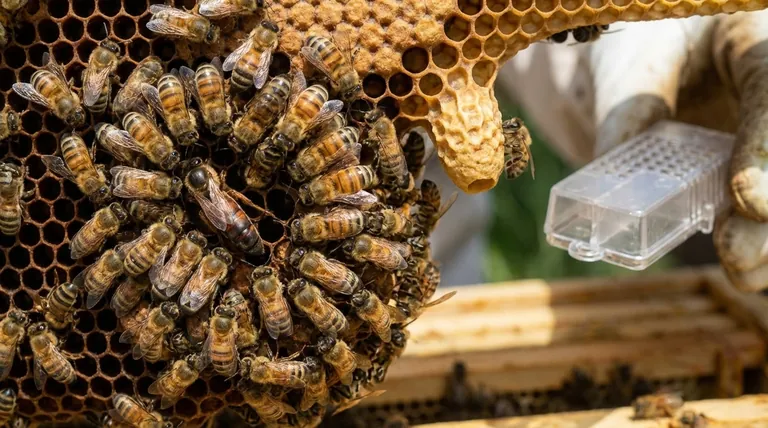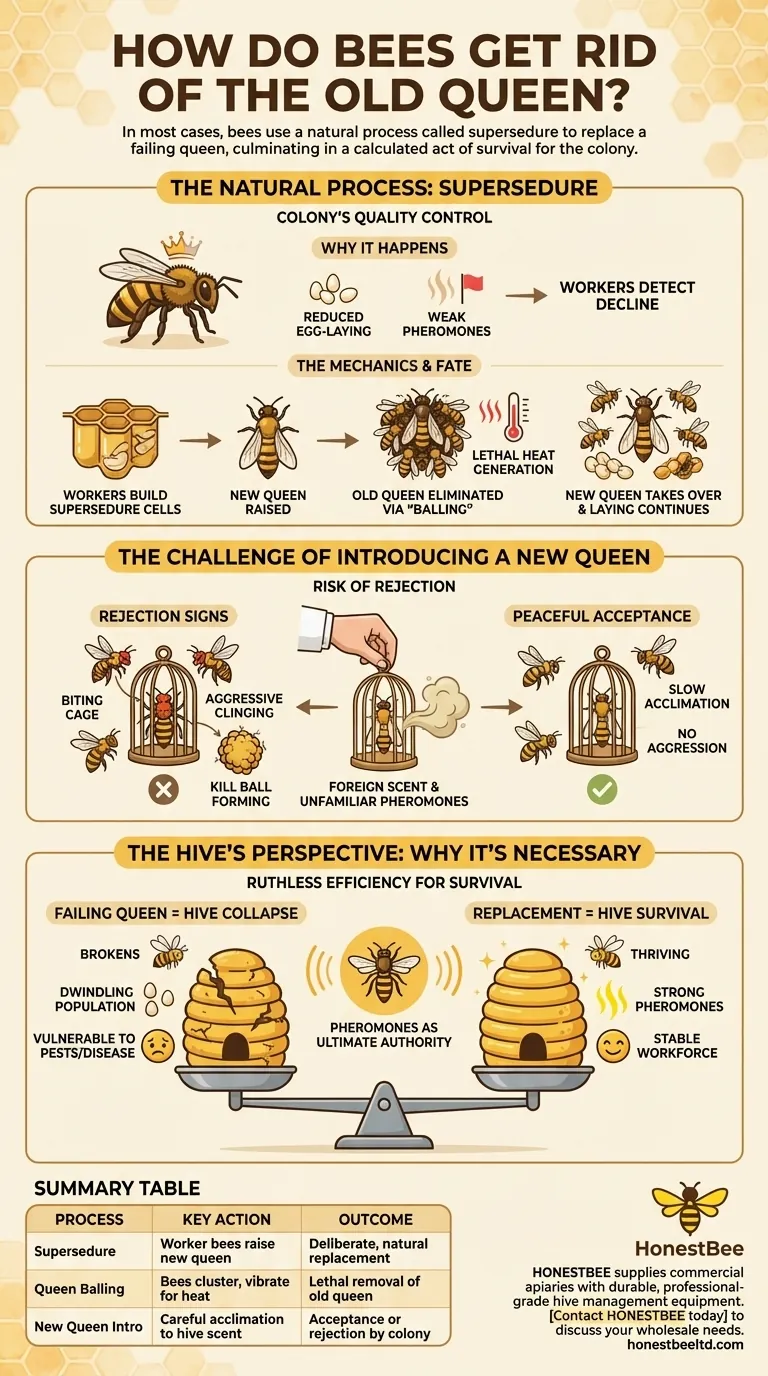In most cases, bees get rid of an old or failing queen through a natural process called supersedure. During this event, the worker bees will raise a new queen, and once she is ready, they will kill the old one. The most common method of killing is forming a tight "ball" around her and vibrating to generate lethal heat.
The decision to replace a queen is not a rebellion but a calculated act of survival for the colony. The hive's health is entirely dependent on a queen's ability to lay eggs and produce strong pheromones, and the worker bees will ruthlessly eliminate any queen—old or new—who fails to meet this standard.

The Natural Process: Supersedure
Supersedure is the colony's own quality control mechanism. It is a calm, deliberate process initiated by the worker bees when they detect that their current queen is no longer viable.
Why Supersedure Happens
A colony decides to replace its queen when her performance declines. This is usually due to old age, which results in a reduced rate of egg-laying or a drop in the output of her essential pheromones.
These chemical signals are the glue that holds the colony together, and a weakening signal is an immediate red flag for the workers.
The Mechanics of Replacement
The bees begin by preparing one or more special "supersedure cells." They then raise new queen larvae within them.
Unlike a more chaotic swarm scenario, the old queen is often allowed to continue laying eggs while her replacement is being reared. This ensures there is no gap in the colony's brood cycle.
The Fate of the Old Queen
Once the new queen hatches and proves her viability, the worker bees will eliminate the old one. They do this by "balling" her—dozens of bees surround her in a tight cluster.
They then vibrate their wing muscles, not to sting, but to raise the temperature inside the ball to a level that is lethal for the queen, effectively cooking her to death.
The Challenge of Introducing a New Queen
Beekeepers often replace queens manually, but this process is fraught with risk because the colony may perceive the new queen as a foreign invader.
The Role of Scent
Worker bees identify their queen and hive mates primarily through pheromones and body odor. A new queen has an unfamiliar scent, which immediately triggers defensive and aggressive behavior.
The colony needs an acclimation period to learn and accept her unique chemical signature as their own.
Signs of Rejection
You can tell a new queen has not been accepted by observing the workers' behavior towards her cage.
Key signs of rejection include workers biting at the cage, aggressively clinging to it, or immediately forming a kill ball around her if she is released too soon. Peaceful acceptance is characterized by a lack of this aggression.
The Hive's Perspective: Why This is Necessary
The seemingly brutal act of killing a queen is a critical function that protects the entire colony from collapse. A hive's survival is not sentimental; it is based on ruthless efficiency.
Pheromones as the Ultimate Authority
The queen's pheromones dictate the stability, mood, and work ethic of the entire hive. A weak pheromonal signal can lead to disorganization and even the development of laying workers, which spells doom for a colony.
The High Cost of a Failing Queen
A queen who cannot lay a sufficient number of fertilized eggs will quickly cause the colony's population to dwindle. A smaller workforce cannot gather enough resources or defend the hive, making it vulnerable to pests, disease, and collapse.
For the bees, replacing a failing queen is the only logical choice.
Applying This to Your Hive Management
Understanding the "why" behind queen replacement allows you to work with the bees' natural instincts, whether you are observing their behavior or actively managing the colony.
- If you are observing a natural supersedure: Trust the process. The bees are often better at raising a queen suited for their specific environment than one you can purchase.
- If you are introducing a new queen: Prioritize a slow, deliberate acclimation period. Ensure the workers show signs of acceptance before fully releasing her from the cage.
Ultimately, the hive's collective decision-making is geared toward one singular goal: ensuring the continuation of the colony.
Summary Table:
| Process | Key Action | Outcome |
|---|---|---|
| Supersedure | Worker bees raise a new queen | A deliberate, natural replacement |
| Queen Balling | Bees cluster and vibrate to generate heat | Lethal removal of the old queen |
| New Queen Introduction | Requires careful acclimation to hive scent | Acceptance or rejection by the colony |
Ensure your apiary's success with the right equipment. The intricate process of queen replacement highlights the precision required in hive management. HONESTBEE supplies commercial apiaries and beekeeping equipment distributors with durable, wholesale-focused supplies that support strong, healthy colonies. From protective gear to hive tools, our products are designed for the professional beekeeper.
Contact HONESTBEE today to discuss your wholesale needs and equip your operation for peak performance.
Visual Guide

Related Products
- Professional Multi-Functional Queen Bee Cage
- Professional Multi-Compartment Queen Cage with Sliding Lid
- Durable Galvanized Steel Spring Queen Bee Cage
- Multi-Function Queen Roller Cage and Catcher
- Professional Queen Cage with Sliding Gate and Feeder Plug
People Also Ask
- What should be done if bees damage the queen cage or harm the queen? Rescue Your Queen and Save Your Hive
- Why might bees reject a new queen? A Guide to Successful Queen Introduction
- What are common mistakes to avoid when using queen cages? Ensure Successful Queen Introduction
- How should a queen cage be maintained over time? Ensure Queen Introduction Success
- What items are needed to place the queen bee's cage in the hive? A Guide to Successful Queen Introduction



















